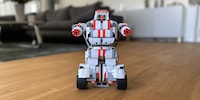
Product test
Test of the Dji RoboMaster S1: not cheap, but unfortunately brilliant
by Raphael Knecht

Playing and learning at the same time sounds like a perfect combination. Robots should make it possible to teach more than just children how to programme. Find out which models are available and what characterises them here.
While you can use some models without any further tinkering, with others you have to follow the assembly instructions before you can put them into operation. However, they are often flexible and can be assembled in different shapes or even extended as part of a set.
You don't need to know how to programme. The robot apps will teach you that. You should be able to read and have a minimal technical understanding to put them in children's hands. Exception: the Tinkerbots. These are designed so that older kindergarten children can also play with them.
In most cases, programming is done using the Scratch programming language. This is a kind of modular system. You don't have to write any code yourself, but simply move commands around or assemble command chains from individual building blocks. This means you don't have to learn a complex programming language straight away, but you do learn the principles of programming.
There are robots that you can have a lot of fun with without programming. These include the rolling ball Sphero and the travelling RoboMaster S1 from DJI - two robots in very different price ranges. Both can be controlled remotely via the app and have built-in game modes; the RoboMaster even has a camera and supports the Scratch and Python programming languages. It is therefore more suitable for advanced users. Our colleague Raphael Knecht took a closer look at both robots.
While the Sphero Mini "only" rolls around, you can programme its movements and have more play options with the football version, the Sphero Bolt has an LED display. It is located inside the transparent ball and is ready for your programming skills. All Sphero models bring you closer to JavaScript.
Like the Sphero, the Photon Robot requires no assembly and can be used straight out of the box. It is designed to develop together with the child and teaches them programming using a modular system.
If you want more freedom with your robot, the Xiaomi Mi Robot Builder is a good choice. You can assemble its 978 individual parts into different animals and machines. The Jimu TankBot and the Jimu Robot TruckBots from Ubtech have fewer parts (190 and 410 respectively), but can also be assembled in a variety of ways. According to the manufacturer, they are suitable for children aged eight and over and have sensors that enable them to recognise objects. They are programmed using an iOS or Android app.
The Codey Rocky from Makeblock is designed for children aged six and over. The associated software "mBlock" lets you programme with code blocks and supports the programming language Phyton, which is considered beginner-friendly, and is compatible with Scratch. It also uses "Arduino IDE", as it contains an Arduino board. Makeblock also uses this in the Dragon Knight spider, although it only has four legs. However, it has eight servo motors and 50 mechanical parts. The Allbots from Velleman, which you programme with an app for Android or iOS and for which you also need an Arduino microcontroller board, are even nerdier.
A variable robot isn't flexible enough for you? Then the only thing that will help is a set that you can expand and build new things. The Lego Mindstorms, for example, are the basis for rebuilding your Lego collection. The motor can be the basis for more than just the robots for which there are building instructions. Various sensors are available for your own creations. The programming interface is based on the Python programming language and uses drag-and-drop so that you can place the building blocks.
Lego Boost is designed for children aged between seven and twelve. Five different models can be assembled from the bricks in the set. The accompanying app not only offers a range of games and activities, but also a "symbol-based programming interface" for children.
With Tinkerbots, the individual building blocks, modules and sensors are significantly larger than with Lego. There are also many different sets to choose from, which can be combined with each other. Some Tinkerbots parts even have a docking surface for Lego bricks. With Tinkerbots Blockly, the manufacturer uses its own visual programming editor with drag-and-drop function. The age recommendations for the sets vary and range from five to ten years as the minimum age.
When I was but a young student, I'd sit in my friend's living room with all my classmates and play on his SuperNES. Since then I've had the opportunity to test out all the newest technology for you. I've done reviews at Curved, Computer Bild and Netzwelt, and have now arrived at Galaxus.de.
Practical solutions for everyday problems with technology, household hacks and much more.
Show all
Behind the scenes
by Daniel Borchers

Product test
by Raphael Knecht

Product test
by Raphael Knecht